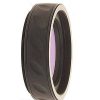Celestron Celestron Oxygen Iii Narrowband Filter – 2 Inch | Eyepiece Accessories & Filters
£129.00 £72.24
Celestron Celestron Oxygen Iii Narrowband Filter – 2 Inch | Eyepiece Accessories & Filters

Observe Rings, Clusters, And Nebulas In High Clarity By Using The Celestron Oxygen Iii Narrowband Filter With Your Telescope. By Filtering And Isolating Ionised-Oxygen Lines Emitted By Planets And Nebulas, This Filter Offers Clear And Contrasting Visuals. It Further Blocks The Visual Spectrum From 400 To 700 Mm By Utilising Its Vacuum-Deposited Coating, Eliminating Halos That Form Behind Stars.
Celestron Oxygen Iii Narrowband Filter – 2 Inch Key Features:
What’S In The Box?
Faqs:
How Does This Filter Block The Visual Spectrum?
The Filter Isolates The Two Doubly Ionised-Oxygen Lines I.E 496 And 501 Mm Lines That Are Emitted By Nebulas And Planets While Blocking The Rest Of The Overall Spectrum. This Results In Contrasting Visuals Between The Sky Background And The Original Target.
What Can You Observe With This Filter?
By Isolating The Background And Light, The Filter Provides A Detailed View Of The Orion Nebula, Crescents, Rings, Rings, Veils, And Other Deep Space Objects.
Is The Celestron Filter Available In Different Sizes?
This Filter Is Available In 1.25” (3 Cm) And 2” (5 Cm) Sizes To Work Appropriately With The Compatible Filter And Telescope.
Can This Filter Eliminate Coloured Halos That Form Behind Bright Space Objects While Observing?
The Filter Has A Hard And Vacuum-Deposited Coating That Helps To Block All Visual Spectrum From 400 To 700 Mm, Eliminating Coloured Halos That Form Behind Stars And Bright Celestial Objects.
Can You Use This Filter As A Substitute For A Light Pollution Filter?
The Light Pollution Filter And Oiii Filter Have Different Spectra And They Differ In Their Purpose And Use. The Light Pollution Filter Is Good For Increasing Contrast For A Wide Range Of Space Objects While The Oiii Filter Is Great For Observing Crescents, Orion Nebula, Veils, Dumbbells, Rings, And More.
Be the first to review “Celestron Celestron Oxygen Iii Narrowband Filter – 2 Inch | Eyepiece Accessories & Filters” Cancel reply
Related products
Eyepiece Accessories & Filters
Eyepiece Accessories & Filters


















Reviews
There are no reviews yet.